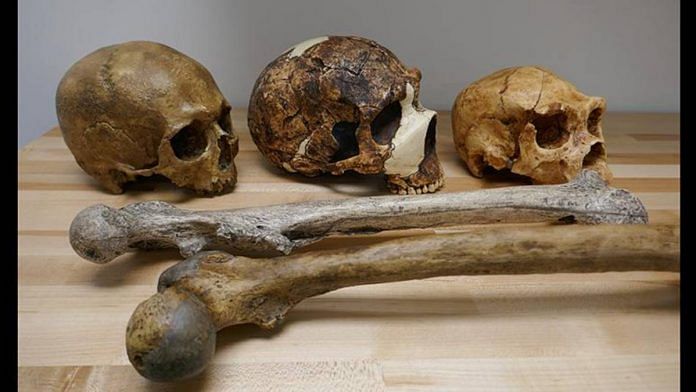New Delhi: Researchers from Germany and the UK who gathered measurements of body and brain size for over 300 fossils of ancient humans across the globe have found that the average body size has fluctuated significantly over the last million years, with larger bodies evolving in colder regions.
A larger size is thought to act as a buffer against colder temperatures — less heat is lost from a body when its mass is large relative to its surface area.
Our species, Homo sapiens, emerged around 3,00,000 years ago in Africa. The genus Homo, which includes the Neanderthals and Homo erectus, has existed for much longer.
A defining trait of the evolution of our genus is a trend of increasing body and brain size. Compared to earlier species such as Homo habilis, we are 50 per cent heavier and our brains are three times larger. But the drivers behind such changes remain highly debated.
The new study indicates that climate — particularly temperature — has been the main driver of changes in body size for the past million years.
The researchers also looked at the effect of environmental factors on brain size, but they found that it tended to be larger when people needed to carry out more complex tasks (such as hunting) to survive.
The team said the size of the human body and brain continues to evolve. The human physique is still adapting to different temperatures, with larger-bodied people, on average, living in colder climes today. Brain size in our species appears to have been shrinking since around 11,650 years ago.
The increasing dependence on technology, such as outsourcing of complex tasks to computers, may cause brains to shrink even more over the next few thousand years. Read more here.
Also read: Is giloy a ‘magic Covid herb’ or liver killer? Mumbai study casts shadow on ayurvedic remedy
‘Elastic’ ice — the latest development from a Chinese lab
For the first time, scientists have managed to create a new form of ice that is elastic and bends just like a wire without breaking — an advance that may help improve our understanding of the physics behind tiny ice structures.
To create the flexible ice, researchers from China used a needle and applied an electric voltage to it inside a chilled chamber. This attracted water vapour and resulted in the formation of icy strands that were a few micrometres in diameter — a fraction of the width of human hair.
Defects in such tiny cracks or pores is what makes ice brittle. But the method used by the Chinese scientists resulted in ice threads of near-perfect crystals.
As a result, the ice could be curved into a partial circle, and would spring back to its original shape when released.
For now, the advance will allow scientists to study the properties for microfibres of ice, which in future could pave the way for new technologies. Read more here.
Could warmer climates see female dragonflies accidentally mating with wrong species?
Male dragonflies are evolving to become less shiny and colourful in hotter climates, a development that could impact how the species breed as, researchers say, this may make it difficult for the females to identify the males.
Many dragonflies have patches of dark black pigmentation on their wings that they use to court potential mates and intimidate rivals.
However, having a lot of dark pigmentation on the wings can heat dragonflies up by as much as 2 degrees Celsius. A team of researchers from the US wanted to understand whether this additional heating might force dragonflies to evolve different amounts of wing pigmentation in different climates.
The team created a database of 319 dragonfly species using field guides and citizen-scientist observations. They gathered information about climate variables in the locations where the dragonflies were observed.
The team found that male dragonflies nearly always responded to warmer temperatures by evolving less wing pigmentation.
They also found that male dragonflies spotted in warmer years tended to have less wing pigmentation than those in cooler years.
One of the implications of this research could be that females may no longer recognise males of their own species, leading to them mating with males of the wrong species. The researchers have called for deeper study into this question. Read more here.
These dinosaurs shrank from ostrich size to that of chicken
Palaeontologists have found that a group of dinosaurs, known as alvarezsaurs, quickly shrank from ostrich-size predators to the chicken-like proportions in order to adapt to the changing conditions.
Alvarezsaurs belong to a diverse group of two-legged dinosaurs with hollow bones and three-toed limbs. Called theropods, this class includes the Tyrannosaurus rex and Velociraptor. There are 21 confirmed species of alvarezsaurs, dating back 160 million years to around 66 million years ago.
Palaeontologists have now found that the fossils of these dinos massively decreased in size between 110 million and 85 million years ago. Before this, they weighed between 10 and 70 kg, but quickly slimmed down to under 5 kg. One of the species shrank to just about 150 gm.
There was a three-fold decrease in the average body size of alvarezsaurs over a period of around 25 million years. In terms of evolutionary time, this is a “quick jump”.
Size reduction was very unusual during this period. Most other dinosaurs were getting bigger during this time. The researchers suspect that a significant shift in global ecosystems during this period may have been behind the alvarezsaurs’ shift in diet and rapid change in size.
Around the same time, Earth was experiencing a massive increase in diversity and abundance of flowering plants.
The increase in plant species could have led to insects like ants, termites and bees flourishing. To take advantage of this new food, alvarezsaurs may have shrunk. Read more here.
(Edited by Manasa Mohan)
Also read: Riemann Hypothesis: 161-yr-old Math mystery Hyderabad physicist is waiting to prove he solved






